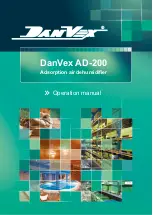
Humidifiers | Controls
Humidifiers
G-12
www.carnes.com
CONTROL OPTIONS -
Figure G
CONTROL HUMIDISTAT
AIR FLOW DETECTION
CONDENSATION
PROTECTION
CONTROL HUMIDISTAT
If an on-off humidistat is used the humidifier will generate
steam at the preset output rate and cycle on or off as
necessary to satisfy the conditioned area requirements.
All humidifiers are preset at the factory for the maximum
rating of the unit. The maximum output may be easily
reset to a lower limit in the range of 25-100% using the
touchscreen.
If Carnes proportional humidistat is used the humidifi-
er will automatically vary the steam output rate in the
range of 25-100% of the humidifiers maximum rating in
response to the signal from the humidistat. Proportional
control provides less cycling of the humidifier.
Either a wall humidistat or duct mounted humidistat in
the return air may be used. The wall mounted humidistat
is the most common as it allows the setting to be easily
changed to accommodate changing requirements or to
lower the relative humidity in the space to prevent con-
densation on windows during extremely cold weather.
In applications where it may be desirable to prevent the
occupants of a space from changing the setting, a duct
mounted humidistat in the return may be used. This is
normally mounted in the equipment room or in the duct
where it is accessible only to maintenance personnel.
AIR FLOW DETECTION
The humidifier control circuit should include some
method to determine air flow. If the steam distributor pipe
is located in a duct where there is no air flow and the
control humidistat is calling for humidity, steam would
be discharged into the duct where it would immediately
condense. Air flow may be detected by several methods.
The humidistat circuit may be interlocked by using a fan
relay if the fan is direct driven. A fan relay is not recom-
mended if a belt driven fan is used as a broken belt would
stop air flow even though the fan relay was closed.
Among the alternatives are the use of a pressure
differential switch that determines air flow by sensing
a pressure differential caused by air movement in the
duct. A paddle type switch is also available to determine
air flow. The pressure differential switch is normally the
preferred device as it is less susceptible to erratic
operation caused by improper positioning in the duct
system. Paddle switches require careful positioning in
the duct to insure sufficient air flow to activate the switch.
WALL HUMIDISTAT
PROPORTIONAL CONTROL
CARNES MODEL
HXHCG
OR
WALL HUMIDISTAT
ON-OFF CONTROL
CARNES MODEL
HXHAA
OR
DUCT HUMIDISTAT
PROPORTIONAL CONTROL
CARNES MODEL
HXHCH
OR
PRESSURE
DIFFERENTIAL
SWITCH
CARNES MODEL
HXAAE
OR
DUCT HUMIDISTAT
ON-OFF CONTROL
CARNES MODEL
HXHAB
AIR
FLOW
SWITCH
CARNES MODEL
HXAAF
OR
DUCT PROPORTIONAL
HIGH LIMIT
HUMIDISTAT
CARNES MODEL
HXHCH
DUCT ON-OFF
HIGH LIMIT
HUMIDISTAT
CARNES MODEL
HXHAD
OR
TEMPERATURE COMPENSATED
(NEW)
PROPORTIONAL or
ON-OFF HUMIDISTAT
CARNES MODEL
HXHAMT
OR
DUCT PROPORTIONAL
HIGH LIMIT
HUMIDISTAT
(NEW)
CARNES MODEL
HXHAN
WALL HUMIDISTAT
(NEW)
PROPORTIONAL CONTROL
CARNES MODEL
HXHAM
OR
OR
DUCT HUMIDISTAT
(NEW)
PROPORTIONAL CONTROL
CARNES MODEL
HXHAN













































